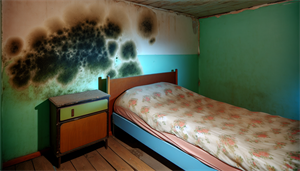If you’re wondering whether mold in your environment can lead to sleep apnea, you’re not alone. In fact, the question “can mold cause sleep apnea?” is quite common. Mold exposure can cause inflammation and nasal congestion, which are known factors in sleep disturbances and may contribute to obstructive sleep apnea.
This article explores the evidence and explains how mold relates to sleep problems, including the possible link to sleep apnea and answering the question, can mold cause sleep apnea?
Key Takeaways
-
Exposure to mold can lead to obstructive sleep apnea and other sleep disturbances due to induced inflammation, nasal congestion, and respiratory issues such as chronic bronchitis and asthma.
-
Molds present in sleeping environments can damage health and property, and may not always be visible, requiring meticulous inspection and proper removal techniques to identify and mitigate.
-
Research has established a clear correlation between exposure to dampness and mold and the onset of various sleep disturbances, suggesting the importance of maintaining dry, mold-free living and working spaces for better sleep quality.
Unveiling the Connection: Mold and Obstructive Sleep Apnea

The quality of your sleep can be significantly affected by mold exposure. As you breathe in mold spores, it results in nasal congestion which in turn leads to breathing difficulties, a prominent factor in sleep apnea and disturbed sleep patterns. Moreover, mold exposure can potentially lead to the development of sleep apnea or hypopnea by inducing inflammation in the upper airway. This inflammation obstructs breathing during sleep, further deteriorating sleep quality.
Worsening of these conditions can also occur when exposed to -1,3-glucan, a primary component of mold cell walls, as it contributes to baseline and chronic bronchitis symptoms.
The Role of Allergic Rhinitis
Allergic rhinitis, also known as hay fever, is a common health issue that can be triggered by exposure to indoor molds like Alternaria and Cladosporium. This condition often leads to adult allergic symptoms, such as:
-
Nasal congestion
-
Irritation
-
Sneezing
-
Runny nose
-
Itchy or watery eyes
-
Itchy throat or ears
-
Coughing
-
Fatigue
These insomnia symptoms can cause difficulty maintaining sleep and make daily activities uncomfortable.
Both the duration and quality of sleep can be significantly impacted by work induce sleep disturbances, potentially resulting in sleep-disordered breathing patterns such as obstructive sleep apnea.
Chronic Sinusitis and Its Impact
Chronic sinusitis, often linked to mold exposure, is another condition that can negatively affect sleep. It involves inflammation in the sinus tissues, which can obstruct the nasal passages and disrupt normal airflow. This obstruction can lead to breathing difficulties during sleep, a significant factor in the development of obstructive sleep apnea.
There is a documented association between mold exposure and the development of chronic sinusitis, although the specific prevalence among affected individuals has not been definitively established.
How Mold-Related Respiratory Issues Affect Sleep Quality
Respiratory problems associated with mold exposure, such as asthma and chronic bronchitis, can have a detrimental effect on sleep quality. For example, 6.5% of participants in a study had chronic bronchitis, and 7.9% had doctor-diagnosed asthma, conditions that can be exacerbated by mold exposure.
These respiratory problems can disrupt regular breathing patterns during sleep, potentially contributing to the onset of sleep apnea.
Identifying Mold in Your Sleeping Environment

Preventing potential harm to both health and property is crucial and this can be achieved by detecting mold in your bedroom. Indications of mold growth may include visible growth in corners or behind furniture, but it can also hide behind wallpaper, paneling, carpet, or walls. Drywall mold growth is facilitated by moisture, which may originate from sources such as leaky roofs, windows, pipes, areas of flooding, and spills.
The development of mold is also influenced by high humidity and inadequate ventilation. Hence, understanding how to identify mold and how to prevent its growth is essential to maintain a healthy sleeping environment.
Visible Mold and Hidden Dangers
Surfaces such as cardboard, paper, wood products, and ceiling tiles, commonly found in bedrooms, can often show visible signs of mold. These signs include discoloration or dark spots on surfaces, a distinct musty odor, and chronic health symptoms such as a runny nose, sneezing, coughing, a sore throat, skin rash, headache, lung irritation, and wheezing.
However, mold can also lurk in hidden places, posing unseen dangers. It is frequently found behind wallpaper, under paneling, or on the back side of wallboards, particularly in areas such as basements or crawl spaces that tend to be dark and damp, creating a moldy environment.
When Mold Hides: Unseen Threats
Detection of unseen mold threats can be through reported mold odors, worsened respiratory issues, or increased allergy symptoms. A persistent musty smell can signal the possible presence of hidden mold. If mold is suspected within walls or ceilings when it is not visually evident, a diluted bleach solution can be applied to the suspected area and observed for discoloration or growth after a few minutes.
Moreover, the presence of mold in air ducts or HVAC systems can be indicated by:
-
Musty odors
-
Visible mold on air vents or drip pans
-
Exacerbated allergy symptoms
-
Breathing difficulties
-
Persistent headaches
-
Nausea
The Science Behind Mold Exposure and Sleep Disorders

Research has demonstrated that exposure to dampness and mold at home and work can elevate the likelihood of experiencing various sleep disturbances, such as symptoms of insomnia, snoring, and excessive daytime sleepiness. These investigations utilized logistic regression models to gauge the connections between dampness at baseline and during follow-up with the onset of sleep disturbances. These models were meticulously adjusted for factors such as gender, age, smoking habit, body mass index (BMI), level of education, asthma, allergic rhinitis, and chronic bronchitis to guarantee the precision of the identified associations.
As these factors have been shown to impair sleep quality, reducing indoor dampness and mold is crucial. This underscores the importance of maintaining a dry, mold-free environment to support healthy sleep patterns.
Examining the Evidence: Studies and Statistics
A correlation between dampness and mold exposure at home and work, and the emergence of sleep disturbances, including insomnia, snoring, and excessive daytime sleepiness has been established by several studies. These studies explored the relationship between mold and dampness and sleep disturbances, examining the effects of glucan exposure, and assessing the impact of exposure to dampness and mold on sleep disturbances and daytime sleepiness among adults.
Cognitive impairment, headaches, fatigue, memory decline, and motor function issues resulting from mold exposure may contribute to sleep disruptions.
From Baseline to Chronic Bronchitis: Mold's Long-Term Effects
Prolonged exposure to mold can lead to chronic respiratory conditions like pulmonary fibrosis, characterized by lung scarring. Chronic bronchitis, a respiratory condition that can be exacerbated by mold exposure, can disrupt sleep. Symptoms like persistent coughing, wheezing, and excessive mucus production can disrupt sleep.
Moreover, patients may experience nocturnal oxygen desaturation and may need inhaled corticosteroids, which can affect their sleep patterns. The bidirectional relationship between chronic bronchitis and obstructive sleep apnea, especially apparent in smokers, further indicates that prolonged exposure to mold can indeed be a risk factor for sleep apnea.
Strategies for Controlling Mold and Protecting Your Sleep

Ensuring that the bedroom is kept dry and unfavorable for mold growth is essential to prevent potential harm to both health and property that mold can cause. Regulating humidity levels and maintaining relative humidity below 60 percent, ideally between 30 percent and 50 percent, can prevent mold growth in a bedroom.
Preventing mold growth in the bedroom is crucial. Here are some ways to achieve this:
-
Increase ventilation to circulate new, clean air
-
Enhance circulation to keep the air moving
-
Remove indoor pollutants to disperse mold and reduce its growth
Preventing Mold: Tips for a Dryer Environment
Controlling indoor humidity is one of the most effective ways of preventing mold growth. Keeping relative humidity below 60 percent, ideally between 30 percent and 50 percent, can greatly reduce the chances of mold developing.
In the event of water issues, it is crucial to promptly address any standing water or spills to minimize the potential for mold growth.
Remediation Techniques: Safely Removing Mold
Removing mold safely is crucial to prevent further exposure. Here are the proper steps for safely removing mold:
-
Use a mixture of bleach, water, and detergent, or a solution of dish soap, vinegar, and water in a spray bottle to effectively remove mold. When handling the bleach solution, wear gloves to protect your skin.
-
Scrub mold from hard surfaces with detergent and water.
-
Remove and dispose of absorbent materials such as carpets.
-
Wrap and tape moldy materials in plastic before double-bagging and disposing of them through a hazardous waste company.
Health Implications Beyond Sleep: Understanding Mold's Broader Impact

Besides sleep disturbances, there can be other serious health implications from mold exposure. These include severe respiratory complications such as fever, difficulty breathing, and lung infection, especially in individuals with autoimmune conditions or chronic lung diseases. Early exposure to mold can also increase the likelihood of children developing asthma.
Long-term effects of mold exposure can encompass a range of health issues, including:
-
Chronic sinusitis
-
Fatigue
-
Organ damage
-
Throat irritation
-
Coughing
-
Nasal stuffiness
-
Eye irritation
-
Skin irritation
-
Potential impact on memory, concentration, judgment, and overall brain function.
When to Seek Professional Help
It’s crucial to recognize when to seek professional help for mold remediation or sleep disorder treatment. Medical advice should be sought for mold-related sleep disturbances if there is an allergy to mold, pre-existing respiratory conditions such as asthma, or persistent insomnia, sleep apnea, or other sleep-related issues due to mold exposure.
Moreover, if there are suspicions of a severe mold infestation, it is advisable to engage a professional for thorough evaluation and remediation.
Summary
In conclusion, the invisible connection between mold exposure and sleep disorders is an important area of concern that warrants attention and action. Whether it’s identifying mold in the sleeping environment, understanding the science behind mold exposure and sleep disorders, or implementing strategies for controlling mold and protecting your sleep, the key takeaway is the importance of maintaining a dry, mold-free environment to support healthy sleep patterns and overall wellbeing.
Frequently Asked Questions
Can mold cause sleep problems?
Yes, mold exposure may compromise sleep and contribute to problems like insomnia, snoring, and excessive daytime sleepiness.
How do I know if mold is affecting my breathing?
If you experience watery, itchy eyes, coughing, wheezing, or shortness of breath, mold may be affecting your breathing. Other symptoms can include nasal congestion, eye irritation, and difficulty breathing, especially for those with allergies or asthma.
What are the signs of mold exposure?
Signs of mold exposure include symptoms like stuffy nose, wheezing, red or itchy eyes, muscle aches, and chronic cough. Some individuals, particularly those with allergies or asthma, may experience more intense reactions.
What does a mold cough sound like?
A mold cough can sound like a "barking" or "hacking" cough. It is commonly caused by allergens such as tree and grass pollen, pet dander, dust mites, or mold.
Can allergies cause sleep apnea?
Yes, allergies can cause sleep apnea by leading to blocked nasal passages and obstructive sleep apnea, affecting sleep quality.


